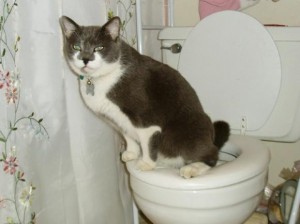This great article which follows on the subject of Can You Flush Cat Poop Down The Toilet? is exceedingly entertaining. Read it for yourself and figure out what you think about it.

Intro
As pet cat proprietors, it's important to bear in mind just how we take care of our feline buddies' waste. While it might seem practical to flush cat poop down the bathroom, this practice can have damaging effects for both the environment and human health.
Ecological Impact
Flushing pet cat poop presents harmful virus and parasites right into the water, posturing a considerable risk to marine communities. These contaminants can adversely impact marine life and concession water high quality.
Wellness Risks
In addition to ecological concerns, purging feline waste can also pose wellness threats to human beings. Pet cat feces may have Toxoplasma gondii, a parasite that can cause toxoplasmosis-- a potentially severe health problem, particularly for pregnant females and people with damaged immune systems.
Alternatives to Flushing
The good news is, there are safer and more liable ways to throw away feline poop. Take into consideration the following alternatives:
1. Scoop and Dispose in Trash
One of the most typical technique of taking care of pet cat poop is to scoop it into a biodegradable bag and toss it in the trash. Be sure to make use of a specialized litter inside story and throw away the waste quickly.
2. Use Biodegradable Litter
Opt for naturally degradable cat clutter made from products such as corn or wheat. These trashes are environmentally friendly and can be safely gotten rid of in the trash.
3. Hide in the Yard
If you have a backyard, think about hiding cat waste in a marked area far from veggie gardens and water resources. Be sure to dig deep enough to avoid contamination of groundwater.
4. Set Up a Pet Waste Disposal System
Buy an animal garbage disposal system especially created for feline waste. These systems utilize enzymes to break down the waste, decreasing odor and environmental influence.
Verdict
Accountable family pet possession expands beyond providing food and sanctuary-- it likewise includes proper waste management. By avoiding flushing cat poop down the bathroom and selecting alternate disposal techniques, we can decrease our ecological impact and protect human health.
Why Can’t I Flush Cat Poop?
It Spreads a Parasite
Cats are frequently infected with a parasite called toxoplasma gondii. The parasite causes an infection called toxoplasmosis. It is usually harmless to cats. The parasite only uses cat poop as a host for its eggs. Otherwise, the cat’s immune system usually keeps the infection at low enough levels to maintain its own health. But it does not stop the develop of eggs. These eggs are tiny and surprisingly tough. They may survive for a year before they begin to grow. But that’s the problem.
Our wastewater system is not designed to deal with toxoplasmosis eggs. Instead, most eggs will flush from your toilet into sewers and wastewater management plants. After the sewage is treated for many other harmful things in it, it is typically released into local rivers, lakes, or oceans. Here, the toxoplasmosis eggs can find new hosts, including starfish, crabs, otters, and many other wildlife. For many, this is a significant risk to their health. Toxoplasmosis can also end up infecting water sources that are important for agriculture, which means our deer, pigs, and sheep can get infected too.
Is There Risk to Humans?
There can be a risk to human life from flushing cat poop down the toilet. If you do so, the parasites from your cat’s poop can end up in shellfish, game animals, or livestock. If this meat is then served raw or undercooked, the people who eat it can get sick.
In fact, according to the CDC, 40 million people in the United States are infected with toxoplasma gondii. They get it from exposure to infected seafood, or from some kind of cat poop contamination, like drinking from a stream that is contaminated or touching anything that has come into contact with cat poop. That includes just cleaning a cat litter box.
Most people who get infected with these parasites will not develop any symptoms. However, for pregnant women or for those with compromised immune systems, the parasite can cause severe health problems.
How to Handle Cat Poop
The best way to handle cat poop is actually to clean the box more often. The eggs that the parasite sheds will not become active until one to five days after the cat poops. That means that if you clean daily, you’re much less likely to come into direct contact with infectious eggs.
That said, always dispose of cat poop in the garbage and not down the toilet. Wash your hands before and after you clean the litter box, and bring the bag of poop right outside to your garbage bins.
https://trenchlesssolutionsusa.com/why-cant-i-flush-cat-poop/

I came across that review about How to Dispose of Cat Poop and Litter Without Plastic Bags while surfing around the search engines. Remember to take a moment to promote this article if you enjoyed reading it. Thank you so much for your time invested reading it.
Call Today
Comments on “Prevent Clogs and Damage: Never Flush Cat Poop Down Your Toilet - Expert Recommendations”